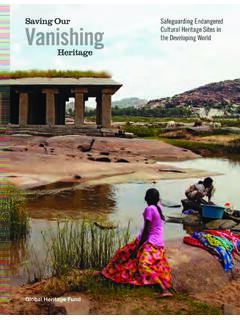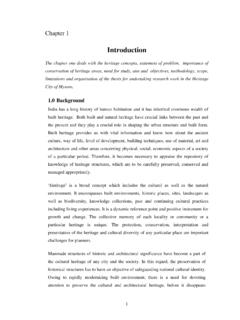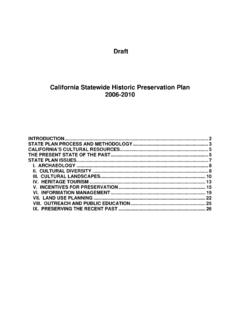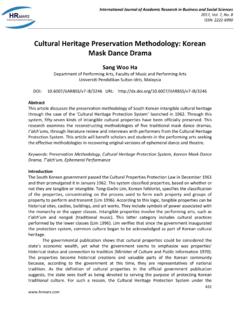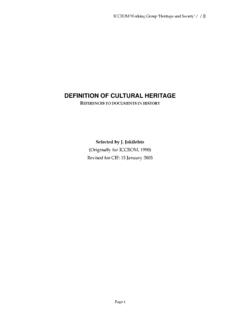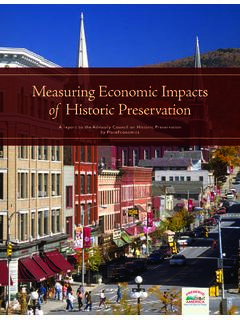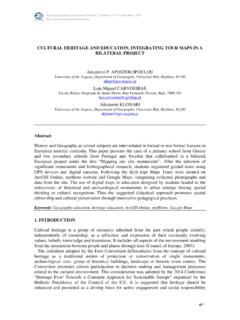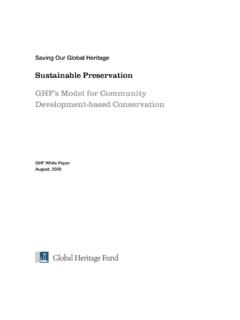Transcription of (c) Copyrighted to National Council for Preservation ...
1 Preservation Education & Research Volume One, 2008 29 preserving tangible cultural Assets:A Framework for a New Dialog in PreservationERIC W. ALLISON and MARY ANN ALLISONP erhaps catalytic questions can serve as one type of systemic attractor to focus the group s or the entire system s intention toward a general area of inquiry (Brown 2002, 18). This paper reports on the emergence of a new type of historic Preservation the Preservation of sites with cultural significance. The term cultural significance requires some definition.
2 Almost all historic sites and buildings can be considered cultural . The Burra Charter defines cultural significance as having aesthetic, historic, scientific, and social aspects (Australia ICOMOS, 12). Using a narrower definition, this paper is concerned with those buildings or sites important for their association with ethnic cultures, marginalized peoples, or mainstream culture heretofore considered undistinguished, which are not generally preservable using current laws and methodology.
3 The purpose of this paper is to begin a dialog, to raise questions rather than provide answers, and to suggest a methodology for addressing potential opportunities. HOW dOES A CITY OR COUNTRY PRESERVE THE MEMORY Of ITS heritage ?Throughout its more than 150-year history in the United States, historic Preservation has been concerned primarily with sites of architectural and historical interest. Increasingly, over the last fifteen years, preservationists have been attending to and experimenting with conceptualizations of sites that are quite unlike those preserved in the past, often giving special attention to sites associated with minority and immigrant groups.
4 Even when there is agreement that a site of cultural significance should be saved, professionals and advocates often struggle with appropriate methods. Very different from preserving rowhouses or adapting a historic train station to new uses, the Preservation of cultural resources often involves intangibles for example, historical activities tangentially related or even unrelated to the physical appearance or history of the structure or how and when to preserve cultural sites of this type is essential for effective historic Preservation in a global society.
5 This new focus exists in the middle ground between two different conceptual frameworks, but fits comfortably in neither. At one end of the spectrum are the successful examples of preser-vation of intangible cultural resources in places such as Korea and Japan. At the other end lies conventional historic Preservation as it has been practiced in much of the Western World, focusing on a historically and architecturally significant structure or place. Existing Preservation efforts came into being in response to the changes brought about by the Industrial Revolution.
6 This new focus arises in response to the systemic social change taking place around the world as a result of the Information Revolution. Just as the tools of the Industrial Revolution needed to be enhanced, modified, or replaced, the tools of historic Preservation must be enlarged to deal with this new York City provides a useful case study for investigating these questions. It plays host to millions of travelers from around the world and has long been a destination for successive waves of immigrants.
7 Successful cultural Preservation will add to the rootedness (Fullilove 2005) of the city s inhabitants, their appreciation of what has gone before, and their (c) Copyrighted to National Council for Preservation Education (NCPE)30 Preservation Education & Research Volume One, 2008 understanding of the ways in which the past influences the present. It will affect the conceptualizations of the city and its history that those millions of visitors take home and, often, of their own relationship to it.
8 Some of New York City s places of significance show the emerging realization that tangible cultural assets are in need of protection and highlight the problematic nature of attempting to preserve them using existing frameworks. The concept of wicked problems, which describes problems not susceptible to solution by ordinary methods, may illuminate this challenging concept; examples from UNESCO s Intangible cultural heritage program are STUdY: RECOGNITION Of cultural ASSETS IN NEW YORK CITYFor most of its one hundred years of existence, the New York City-based Municipal Art Society (MAS) has been a good government organization.
9 Since the 1940s, it has included historic Preservation in its mission statement. In the early 1990s, Ned Kaufman, its Associate Director of Issues, set up a committee on cultural and historic sites (Place Matters 2007; Reaven 2007). Among the other organizations interested in cultural Preservation was City Lore, founded to produce programs and publications that convey the richness of New York City s cultural heritage (City Lore 2007). In 1997, City Lore joined with the MAS to produce a conference entitled History Happened Here.
10 Response from conference attendees indicated that concern for the Preservation of cultural sites was shared by other groups and individuals. As a result, MAS and City Lore formed Place Matters the following year. Place Matters has been conducting a census of significant cultural places in New York City since that time. To date, it has identified 580 Places That Matter in New York City (Place Matters 2006). If these were all conventional sites of architectural or historical significance, the next step would be to secure the protections of landmark designation.
